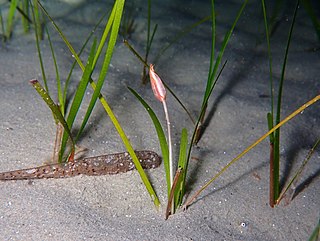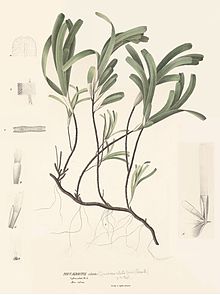
Seagrasses are the only flowering plants which grow in marine environments. There are about 60 species of fully marine seagrasses which belong to four families, all in the order Alismatales. Seagrasses evolved from terrestrial plants which recolonised the ocean 70 to 100 million years ago.

A seagrass meadow or seagrass bed is an underwater ecosystem formed by seagrasses. Seagrasses are marine (saltwater) plants found in shallow coastal waters and in the brackish waters of estuaries. Seagrasses are flowering plants with stems and long green, grass-like leaves. They produce seeds and pollen and have roots and rhizomes which anchor them in seafloor sand.

Barbour's seahorse is a species of fish of the family Syngnathidae.

Halophila johnsonii, or Johnson's seagrass, is a small, asexual seagrass in the family Hydrocharitaceae. It occurs only on the southeastern coast of Florida, and was the first marine plant listed on the United States endangered species list, though it was removed from listing in April 2022. Female flowers have been observed, but even with decade long observational studies, neither male flowers nor seed have ever been observed.
Amphibolis antarctica is a species of flowering plant in the family Cymodoceaceae. It is referred to by the common names wire weed or sea nymph, and is a seagrass found in coastal waters of southern and western Australia.

Halophila is a genus of seagrasses in the family Hydrocharitaceae, the tape-grasses. It was described as a genus in 1806. The number of its contained species, and its own placement in the order Alismatales, has evolved.

Halophila ovalis, commonly known as paddle weed, spoon grass or dugong grass, is a seagrass in the family Hydrocharitaceae. It is a small herbaceous plant that naturally occurs in sea beds and other saltwater environments in the Indo-Pacific. It was introduced as isolated populations in Florida, Cuba and Antigua.

Posidonia australis, also known as fibre-ball weed or ribbon weed, is a species of seagrass that occurs in the southern waters of Australia. It forms large meadows important to environmental conservation. Balls of decomposing detritus from the foliage are found along nearby shore-lines.
The Seagrasses of Western Australia are submerged flowering plants found along the coast, around islands, and in Estuaries of Western Australia. The region contains some of the largest seagrass meadows in the world, and is the most diverse in the number of species. The variety of habitats along its western and southern coasts is often soft sands in shallow subtropical waters, ideal for these plants.

Enhalus is a monotypic genus of marine flowering plants. The sole species is Enhalus acoroides. Enhalus is a large seagrass native to coastal waters of the tropical Indian and Western Pacific Oceans. It is the only species of seagrass that does aerial surface pollination in which the pollen and the styles remain dry. Enhalus is surface pollinated with male flowers that detach from the plant to float on the surface until they reach a female flower where pollination can occur. Enhalus acoroides is considered a slow-growing, "climax" species.

Thalassia testudinum, commonly known as turtlegrass, is a species of marine seagrass. It forms meadows in shallow sandy or muddy locations in the Caribbean Sea and the Gulf of Mexico. Turtle grass and other seagrasses form meadows which are important habitats and feeding grounds. The grass is eaten by turtles and herbivorous fish, supports many epiphytes, and provides habitat for juvenile fish and many invertebrate taxa.

Zostera marina is a flowering vascular plant species as one of many kinds of seagrass, with this species known primarily by the English name of eelgrass with seawrack much less used, and refers to the plant after breaking loose from the submerged wetland soil, and drifting free with ocean current and waves to a coast seashore. It is a saline soft-sediment submerged plant native to marine environments on the coastlines of northern latitudes from subtropical to subpolar regions of North America and Eurasia.

Cymodocea nodosa is a species of seagrass in the family Cymodoceaceae and is sometimes known as little Neptune grass. As a seagrass, it is restricted to growing underwater and is found in shallow parts of the Mediterranean Sea and certain adjoining areas of the Atlantic Ocean.

Halophila decipiens, commonly known as Caribbean seagrass or paddle grass, is a seagrass in the family Hydrocharitaceae. It grows underwater on sandy or muddy sea floors in shallow parts of tropical seas.

Zostera noltii is a species of seagrass known by the common name dwarf eelgrass. It is found in shallow coastal waters in north western Europe, the Mediterranean Sea, Black Sea, Caspian Sea and Aral Sea and on islands in the Atlantic off the coast of northwest Africa. It is an important part of the intertidal and shallow subtidal ecosystems of estuaries, bays and lagoons.

Halodule uninervis is a species of seagrass in the family Cymodoceaceae. It is native to the western Pacific and Indian Oceans. Common names include narrowleaf seagrass in English and a'shab bahriya in Arabic.
Halodule pinifolia is a seagrass species in the genus Halodule. It is found in shallow sea waters.

Zostera muelleri is a southern hemisphere temperate species of seagrass native to the seacoasts of South Australia, Victoria and Tasmania. and New Zealand. Today, Zostera muelleri can be found in regions of Australia, New Zealand, and Papua New Guinea, as well as areas of the eastern Indian Ocean, and the southwest and western central Pacific Ocean. Zostera muelleri is a marine angiosperm, and is commonly referred to as eelgrass or garweed. It is a fast growing and readily colonizing species that serves as a feeding ground for wading birds and aquatic animals, and a breeding ground for juvenile fish and shrimp species.
Phyllospadix serrulatus is a species of aquatic plant in the Zosteraceae family. It is referred to by the common name toothed surfgrass, and is found along the shorelines of British Columbia and southern Alaska. It is also found in Oregon. It grows in salt marshes in the intertidal zone.

Syringodium isoetifolium, commonly known as noodle seagrass, is a species of flowering plant in the family Cymodoceaceae, growing underwater in marine habitats. It forms seagrass meadows in shallow sandy or muddy locations in the Indian and Pacific Oceans.
















